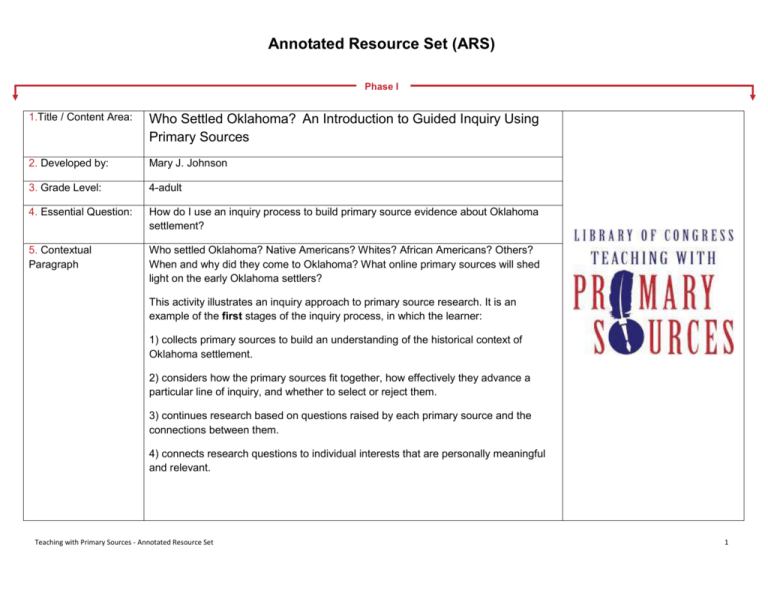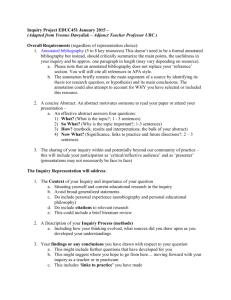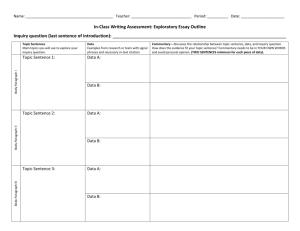Oklahoma Inquiry
advertisement

Annotated Resource Set (ARS) Phase I 1.Title / Content Area: Who Settled Oklahoma? An Introduction to Guided Inquiry Using Primary Sources 2. Developed by: Mary J. Johnson 3. Grade Level: 4-adult 4. Essential Question: How do I use an inquiry process to build primary source evidence about Oklahoma settlement? 5. Contextual Paragraph Who settled Oklahoma? Native Americans? Whites? African Americans? Others? When and why did they come to Oklahoma? What online primary sources will shed light on the early Oklahoma settlers? This activity illustrates an inquiry approach to primary source research. It is an example of the first stages of the inquiry process, in which the learner: 1) collects primary sources to build an understanding of the historical context of Oklahoma settlement. 2) considers how the primary sources fit together, how effectively they advance a particular line of inquiry, and whether to select or reject them. 3) continues research based on questions raised by each primary source and the connections between them. 4) connects research questions to individual interests that are personally meaningful and relevant. Teaching with Primary Sources - Annotated Resource Set 1 6. Resource Set Today in History Cheyenne Sun Dancer 1909 Indian Territory Map 1889 Cherokee Nation Denied Foreign Nation Status 1838 Petition to General Scott Indian Removal Interactive Map “Today in History” is a good starting point with links. Photographs can answer questions about groups that settled a territory. Maps often show patterns of settlement. Legal documents build historical background for patterns of settlement. Were there other points of view about Native American settlement? Which point of view won out? American Treasures of the Library of Congress Cherokee Heritage Center PBS Series http://www.loc.gov/exh ibits/treasures/trr050.ht ml http://www.cherokeehe ritage.org/cherokeeheri tage/images/archive/pe tition_to_general_scott. pdf http://memory.loc.gov/ ammem/today/nov16.h tml Panoramic Photographs, http://hdl.loc.gov/loc.g Library of Congress, md/g4021e.ct000225 American Memory http://hdl.loc.gov/loc.p np/pan.6a08724 Teaching with Primary Sources - Annotated Resource Set Andrew Jackson: Good, Evil & The Presidency http://www.pbs.org/kce t/andrewjackson/featur es/ 2 “We Shall Remain” “On Fast Horses” Where do I go from here? Where can I learn more about how the Native Americans came to Oklahoma? Were Native Americans the only people who settled Oklahoma? Personal interests and curiosity continue to guide the inquiry. http://www.pbs.org/wg bh/amex/weshallremain / Historical Newspapers http://eagle.brooklynpu bliclibrary.org/Repositor y/ml.asp?Ref=QkVHLzE4 ODkvMDQvMjIjQXIwMD QzMA==&Mode=Gif&Lo cale=english-skincustom Use secondary sources in combination with primary sources to build background knowledge. Notes/Comments: Depending on the grade level of students in this inquiry, the two identified text documents may be too difficult for extended analysis, but the corresponding websites offer explanations that will aid primary source analysis. The teaching team will need to demonstrate how to locate, copy, and paste permanent URLs of items on the Library of Congress website. The teaching team will need to demonstrate navigation tools and search strategies for historic newspaper collections. The ARS does not have to be pretty, just functional! Assess the process rather than the design. Teaching with Primary Sources - Annotated Resource Set 3 Phase II Foundations Annotations 7. Curriculum Connections Social Studies, Language Arts, Information and Communications Technology (ICT) 8. Curriculum Standards History Standards (Colorado). (Note: Identify similar curriculum standards by state as necessary.) 2.1 Students know how to formulate questions and hypotheses regarding what happened in the past and to obtain and analyze historical data to answer questions and test hypotheses. 2.2 Students know how to interpret and evaluate primary and secondary sources of historical information. 2.3 Students apply knowledge of the past to analyze present-day issues and events from multiple, historically objective perspectives. 9. Content & Thinking Objectives Content Objectives: Objective 1: Understand the differences between primary and secondary sources. Objective 2: Identify primary source collections related to student-generated questions. Objective 3: Search for, select, question, and analyze primary sources for relevance to a particular historical inquiry. Thinking Objectives: Objective 1: Recognize and define stages of inquiry. Objective 2: Develop strong questions with potential to identify a focus and guide further inquiry. Objective 3: Decide which primary sources to accept or reject based on relevance to topic and questions. 10. Learning Activities & Strategies Teaching with Primary Sources - Annotated Resource Set 4 Introduce lesson by asking learners to look around them and guess how their ancestors came to be residents of Oklahoma. What do they already know about Oklahoma settlement? Explain beginning stages of inquiry process based on Kuhlthau’s research on the information search process. Demonstrate inquiry (both skills and thinking) using various online primary source collections linked through a wiki or another online tool. Provide exploration time for primary source searching, working with the ARS template, and developing a beginning annotated resource set (ARS). Use (1) Library of Congress “Thinking about Primary Sources” graphic organizer or (2) “Primary Source Analysis Tool” with teachers guide to guide next steps in developing the ARS. 11. Assessment Strategies “Timeline Reflection of My Inquiry Process” (Kuhlthau, Maniotes, Caspari, Guided Inquiry book, page 121) Rubric for Annotated Resource Set (ARS) Use (1) Library of Congress “Thinking about Primary Sources” graphic organizer or (2) “Primary Source Analysis Tool” with teachers guide to guide next steps in developing the ARS. AASL Standards for the 21st Century Learner Self-Assessment Strategies: 1.4.1 Monitor own information-seeking processes for effectiveness and progress, and adapt as necessary. 2.4.1 Determine how to act on information (accept, reject, modify). Teaching with Primary Sources - Annotated Resource Set 5 Phase III Inquiry & 21st Century Learning Annotations 12. 21st Century Learning AASL Standards for the 21st Century Learner 1.1 Skills 1.1.1 Follow an inquiry- based process in seeking knowledge in curricular subjects, and make the real- world connection for using this process in own life. 1.1.6 Read, view, and listen for information presented in any format (e.g., textual, visual, media, digital) in order to make inferences and gather meaning. 1.1.8 Demonstrate mastery of technology tools for accessing information and pursuing inquiry. 13. Inquiry Strategies Model a beginning inquiry at the stages of connect, wonder, and investigate. Use journaling or in-class discussion to consider the effectiveness of questions as well as the reasons for selecting or rejecting specific primary sources. Allow ample time for exploration without pressure as students learn to navigate and search a variety of primary source collections and websites. 14. Literacy Strategies/Tools Strategies: Use strategies for determining importance in text to pull out the important ideas. Use strategy of “recall summarize paraphrase extend” (Guided Inquiry p136) to take notes on and synthesize new information from texts Use visual strategies to analyze images and documents. Use journal to document process of inquiry and track own learning through writing and images. Use inquiry strategies of 6 C’s to explore topic, formulate focus, and understand material (collaborate, converse, choose, continue, chart, compose) (Guided Inquiry p.137) Create a logical argument with documents that back an idea. Teaching with Primary Sources - Annotated Resource Set 6 Tools: At the beginning stages of this inquiry, students can use a variety of online interactive tools to gather and organize the primary sources that they identify for potential use. This model uses the ARS, but students could also use Google Tools, blogs, or wikis to gather and record sources and ideas. Other Resources 15. Web Resources See “Primary Source Librarian” wiki as well as this ARS for links to primary source collections. Consult bibliographies for text, newspaper, photograph & image, map, sound & film, and artifact & ephemera collections online in Primary Source Teaching the Web 2.0 Way-K12 (Johnson, Mary J.). 16. Secondary Sources Students will absolutely need secondary sources to help them understand the primary sources identified in this activity and in their own beginning inquiries. It is vital that the teaching team and the students work closely with the teacher/librarian to identify and access library reference sources (print and online), build effective searches using search engines, and pre-identify specific websites related to their historical inquiries. 17. Print and Other Media Resources See “Secondary Sources” above. Note that PBS programs played a role in the model inquiry in this lesson. Teaching with Primary Sources - Annotated Resource Set 7







